
Boxing is a combat sport and a martial art in which two people, usually wearing protective gloves and other protective equipment such as hand wraps and mouthguards, throw punches at each other for a predetermined amount of time in a boxing ring.

Roberto Durán Samaniego is a Panamanian former professional boxer who competed from 1968 to 2001. He held world championships in four weight classes: Lightweight, welterweight, light middleweight and middleweight. Duran also reigned as the undisputed and lineal lightweight champion and the lineal welterweight champion. He is also the second boxer to have competed over a span of five decades, the first being Jack Johnson. Durán was known as a versatile, technical brawler and pressure fighter, which earned him the nickname "Manos de Piedra" for his formidable punching power and excellent defense.

Ray Charles Leonard, best known as Sugar Ray Leonard, is an American former professional boxer, motivational speaker, and occasional actor. Often regarded as one of the greatest boxers of all time, he competed professionally between 1977 and 1997, winning world titles in five weight classes; the lineal championship in three weight classes; as well as the undisputed welterweight championship. Leonard was part of the "Four Kings", a group of boxers who all fought each other throughout the 1980s, consisting of Leonard, Roberto Durán, Thomas Hearns, and Marvin Hagler. Leonard also won a light welterweight gold medal at the 1976 Summer Olympics.
Cauterization is a medical practice or technique of burning a part of a body to remove or close off a part of it. It destroys some tissue in an attempt to mitigate bleeding and damage, remove an undesired growth, or minimize other potential medical harm, such as infections when antibiotics are unavailable.

Bare-knuckle boxing is a full-contact combat sport based on punching without any form of padding on the hands. The sport as it is known today originated in 17th-century England and differs from street fighting as it follows an accepted set of rules.

Cotton swabs or cotton buds are wads of cotton wrapped around a short rod made of wood, rolled paper, or plastic. They are most commonly used for ear cleaning, although this is not recommended by physicians. Other uses for cotton swabs include first aid, cosmetics application, cleaning, infant care and crafts. Some countries have banned the plastic-stemmed versions in favor of biodegradable alternatives over concerns about marine pollution.

A nosebleed, also known as epistaxis, is an instance of bleeding from the nose. Blood can flow down into the stomach, and cause nausea and vomiting. In more severe cases, blood may come out of both nostrils. Rarely, bleeding may be so significant that low blood pressure occurs. Blood may also come up the nasolacrimal duct and out from the eye.
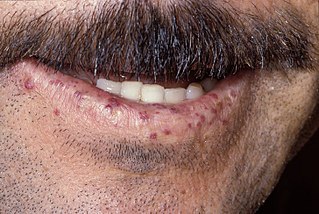
Hereditary hemorrhagic telangiectasia (HHT), also known as Osler–Weber–Rendu disease and Osler–Weber–Rendu syndrome, is a rare autosomal dominant genetic disorder that leads to abnormal blood vessel formation in the skin, mucous membranes, and often in organs such as the lungs, liver, and brain.

A periorbital hematoma, commonly called a black eye or a shiner, is bruising around the eye commonly due to an injury to the face rather than to the eye. The name refers to the dark-colored bruising which is the result of accumulated blood and fluid in the loose areolar tissue following a blow to the head. This blood tracks freely under the scalp producing a generalised swelling over the dome of the skull but cannot pass into either occipital or the temple regions because of the bony attachments of the occipitofrontalis muscle. But this fluid can, however, track forward into the eyelid because the occipitofrontalis muscle has no bony attachment anteriorly. This leads to formation of hematoma a few hours after the head injury or cranial operation. If injury is more extensive, potentially even a skull fracture, an apparent black eye can sometimes worsen and may require professional medical treatment before it will resolve. This is more likely if the area around both eyes has been injured or if there is a history of prior head injury or fracture around the eye. Though disfiguring, the vast majority of black eyes are not serious, require little or no treatment, and will resolve spontaneously within a week or two.
An antihemorrhagic agent is a substance that promotes hemostasis. It may also be known as a hemostatic agent.

Clinch fighting or trapping is the part of stand-up fighting where the combatants are grappling in a clinch, typically using clinch holds. Clinching the opponent can be used to eliminate the opponent's effective usage of some kicks, punches, and melee weapons. The clinch can also be used as a medium to switch from stand-up fighting to ground fighting by using takedowns, throws or sweeps.
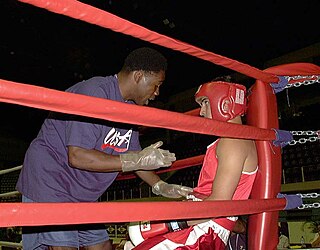
In combat sports, a cornerman, or second, is a coach or trainer assisting a fighter during a bout. The cornerman is forbidden to instruct and must remain outside the combat area during the round. In the break, they are permitted to enter the ring and minister to their fighter.
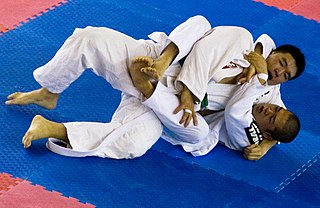
In combat sports, a spinal lock is a multiple joint lock applied to the spinal column, which is performed by forcing the spine beyond its normal ranges of motion. This is typically done by bending or twisting the head or upper body into abnormal positions. Commonly, spinal locks might strain the spinal musculature or result in a mild spinal sprain, while a forcefully and/or suddenly applied spinal lock may cause severe ligament damage or damage to the vertebrae, and possibly result in serious spinal cord injury, stroke, or death. Spinal locks and cervical locks are forbidden in IBJJF Brazilian jiu-jitsu competitions, amateur mixed martial arts (MMA), multiple forms of no Gi jiu-jitsu, judo, and other martial arts. However, professional MMA and some Brazilian jiu-jitsu competitions do permit spinal locks and, particularly, neck cranks, and such moves are trained in various MMA and Brazilian jiu-jitsu schools.
Finnfight or Scandinavian open NHB Championships (SNC) was an annual mixed martial arts competition in Turku, Finland. Contrary to most other mixed martial arts organizations and competitions, elbow strikes, knee strikes, and headbutts from any position were legal.

Bone wax is a waxy substance used to help mechanically control bleeding from bone surfaces during surgical procedures.
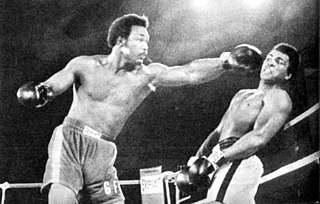
Professional boxing, or prizefighting, is regulated, sanctioned boxing. Professional boxing bouts are fought for a purse that is divided between the boxers as determined by contract. Most professional fights are supervised by a regulatory authority to guarantee the fighters' safety. Most high-profile bouts obtain the endorsement of a sanctioning body, which awards championship belts, establishes rules, and assigns its own judges and referees.
José Martín Castillo is a Mexican former professional boxer. He represented his native country of Mexico at the 1996 Summer Olympics, and is a former World Boxing Association Super Flyweight champion.
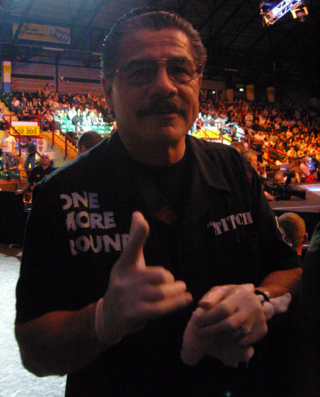
Jacob "Stitch" Duran is an American professional cutman who works in boxing and mixed martial arts fights. He is of Mexican descent and grew up in Planada, California.
José Uzcátegui is a Venezuelan professional boxer who held the IBF super middleweight title from 2018 to 2019.
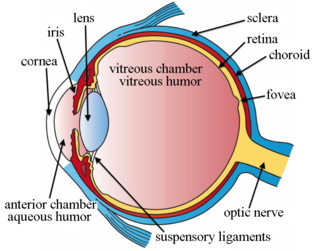
Intravitreal injection is the method of administration of drugs into the eye by injection with a fine needle. The medication will be directly applied into the vitreous humor. It is used to treat various eye diseases, such as age-related macular degeneration (AMD), diabetic retinopathy, and infections inside the eye such as endophthalmitis. As compared to topical administration, this method is beneficial for a more localized delivery of medications to the targeted site, as the needle can directly pass through the anatomical eye barrier and dynamic barrier. It could also minimize adverse drug effects on other body tissues via the systemic circulation, which could be a possible risk for intravenous injection of medications. Although there are risks of infections or other complications, with suitable precautions throughout the injection process, chances for these complications could be lowered.

















